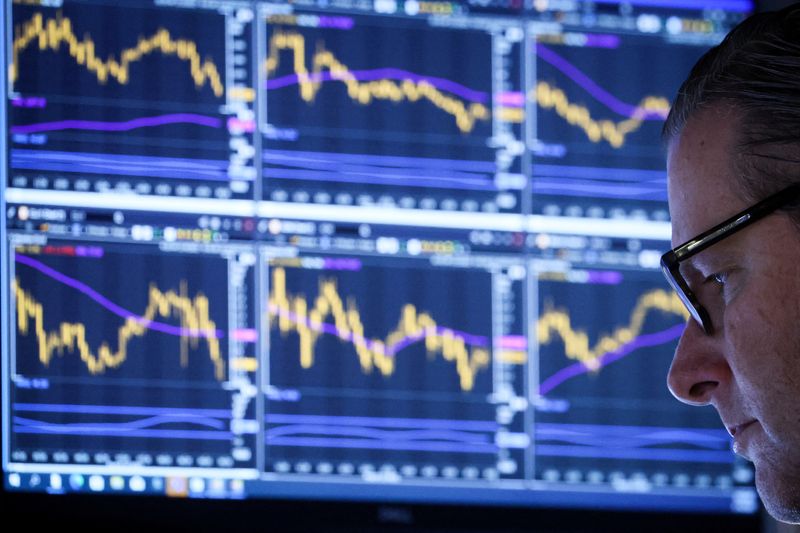Marketmind-Deep breaths as banks calm, but only a bit
2023.03.15 07:04

© Reuters. FILE PHOTO: A specialist trader works inside a post on the floor of the New York Stock Exchange (NYSE) in New York City, U.S., March 14, 2023. REUTERS/Brendan McDermid
A look at the day ahead in U.S. and global markets from Mike Dolan
Hyperventilating world markets have finally caught their breath as the U.S. bank shock of the past week appeared to calm somewhat and gyrating interest rates found a level.
But volatility is likely to persistMOVE> – not least in pre-meeting blackout periods for major central banks – as easing financial system tensions merely re-introduce rate hike risks that sticky US inflation readings seem to warrant.
And with longer-running global banking sagas exposed by the events of the past week, nerves were jangled again on Wednesday as Credit Suisse shares dropped by as much as 10.5% to a new record low, as its largest investor said it couldn’t give the Swiss bank more financial assistance.
After bank stocks rebounded somewhat on Tuesday, despite Moody’s (NYSE:) downgrading the credit outlook for the entire U.S. banking system, attention turned to tighter regulation and workouts for the worst affected firms.
The Federal Reserve is considering tougher rules and oversight for midsize banks similar in size to Silicon Valley Bank, which collapsed suddenly last week. Strengthened rules on banks in the $100 billion to $250 billion range could ape those for larger more systemic banks and involve stringent capital and liquidity requirements or beefed up annual “stress tests”.
Even though reports abounded of depositor flight from the smaller weaker banks to the larger financial firms, stock prices in the sector at large caught a breath.
That continued in Asia on Wednesday, although Europe’s bank stocks and wider bourses stayed in the red and U.S. futures were a touch lower. The equity volatility gauge hugged Tuesday’s close at 23.
Apart from fresh Credit Suisse angst, another reason for the persistent trepidation in Europe was signals from central bank sources that the European Central Bank would push ahead with a hefty half-point interest rate rise at its policymaking meeting on Thursday.
If the ECB stays the course and the Fed follows suit next week, anxiety about further banking ructions may return – or at least see further wild volatility in rates markets that could end up having similar effects.
U.S. Treasury market volatility is already at its highest since the aftermath of the last big banking crash in 2009, with the biggest drop since 1987 in 2-year Treasury yields on Monday followed by the biggest one-day jump in 14 years on Tuesday.
On Wednesday, 2-year yields settled about 4.3% – still 80 basis points lower than they were a week ago, but up half a point from Tuesday’s trough. Futures markets now see an 80% chance of a quarter-point Fed hike next week to a 4.75-5.0% range, with a ‘terminal rate’ at 5% in May.
The dollar was slightly higher as rates recalibrated.
Chinese industrial and retail updates for February showed the post-COVID lockdown recovery underway but at an underwhelming pace.
Sterling was steady at investors awaited the Spring UK budget, with bumper tax receipts allowing finance minister Jeremy Hunt to offer some relief to pensions and childcare while extending critical energy price supports.
With widespread trepidation about the impact of the SVB collapse on the U.S. tech sector at large, Facebook-parent Meta said on Tuesday it would cut 10,000 jobs this year, making it the first Big Tech company to announce a second round of mass layoffs as the industry braces for a deep economic downturn.
Apple (NASDAQ:) supplier Foxconn said on Wednesday it expected smart consumer electronics demand would decline slightly this year, as it reported a 10% fall in fourth-quarter net profit from a year earlier.
In more upbeat tech news, startup OpenAI said it is beginning to release a powerful artificial intelligence model known as GPT-4, with image as well as text prompts in searches.
Key developments that may provide direction to U.S. markets later on Wednesday:
* US Feb retail sales and producer prices, US March NAHB housing market index, Empire State manufacturing survey, Jan business inventories.
* UK government’s Spring budget
* US corp earnings: Adobe (NASDAQ:)
(By Mike Dolan, editing by Elaine Hardcastle; mike.dolan@thomsonreuters.com. Twitter: @reutersMikeD)








